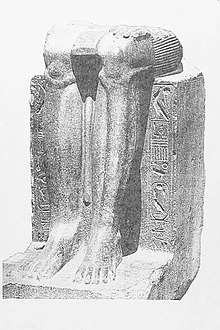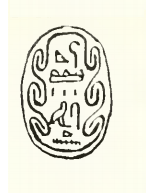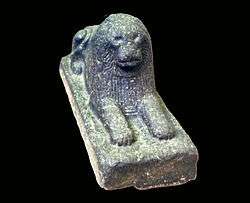Fifteenth Dynasty of Egypt
The Fifteenth Dynasty was a foreign dynasty of ancient Egypt. It was founded by Salitis, a Hyksos from West Asia whose people had invaded the country and conquered Lower Egypt.[1] The 15th, 16th, and 17th Dynasties of ancient Egypt are often combined under the group title, Second Intermediate Period. The 15th Dynasty dates approximately from 1650 to 1550 BC.[2][3]
Egypt | |||||||||||||
|---|---|---|---|---|---|---|---|---|---|---|---|---|---|
| 1650 BC–ca. 1550 BC | |||||||||||||
 Egypt during the Fifteenth Dynasty | |||||||||||||
| Capital | Avaris | ||||||||||||
| Common languages | Egyptian language | ||||||||||||
| Religion | ancient Egyptian religion | ||||||||||||
| Government | Absolute monarchy | ||||||||||||
| Historical era | Bronze Age | ||||||||||||
• Established | 1650 BC | ||||||||||||
• Disestablished | ca. 1550 BC | ||||||||||||
| |||||||||||||
| Periods and Dynasties of Ancient Egypt | ||||||||||||||||||
|---|---|---|---|---|---|---|---|---|---|---|---|---|---|---|---|---|---|---|
|
All years are BC | ||||||||||||||||||
|
Early
|
||||||||||||||||||
|
||||||||||||||||||
|
||||||||||||||||||
|
||||||||||||||||||
|
||||||||||||||||||
|
||||||||||||||||||
|
||||||||||||||||||
|
||||||||||||||||||
|
Ptolemaic (Hellenistic)
|
||||||||||||||||||
|
See also: List of Pharaohs by Period and Dynasty Periodization of Ancient Egypt | ||||||||||||||||||
Dynastic history
The kings of the Fifhteenth Dynasty are said to have been Canaanite.[4] Pharaoh Kamose is known to have referred to Apophis, one of the kings of the dynasty, as "Chieftain of Retjenu (i.e. Caanan)".[5][6] The kings of the Fifhteenth Dynasty formed "the second Asiatic Kingdom in the Delta", covering an area which may have included Canaan itself, although the archaeological record is sparse.[7][8] The dynasty probably lasted for a period of about 108 years.[9][10]
The first king, also described as a Hyksos (ḥḳꜣw-ḫꜣswt, a "shepherd" according to Africanus), led his people into an occupation of the Nile Delta area and settled his capital at Avaris.[4] These events put an end to the Fourteenth Dynasty of Egypt.[4] There are no proof of conflict at that time however, and the settling of the Canaanite populations may have be done rather peacefully in the power vacuum left by the desintegration of the Fourteenth Dynasty.[6] But subsequent relations with Egyptian polities where marked with violent conflict.[11]
Identity
The people of Avaris in the Nile Delta were called "Aamu" by the Egyptians, which was also the term used to designate the inhabitants of Syria and Palestine, or the enemies of Ramses II at the battle of Kadesh.[12] This has generally been translated as "Western Asiatics" by Egyptologists.[12]
The naming "Hyksos" was traditionaly used to designate foreign chieftains, and more specifically "rulers of the Asiatics", already before the Fifteenth Dynasty and also after it.[13][12] It was not an official title of the rulers of the Fifteenth dynasty, and is never encountered together with royal titulature, except in one rare instance in an inscription from Tell el-Dab'a mentioning an unknown king and describing him as an Hyksos.[13] "Hyksos" was rather a generic term which is encountered separately from royal titulature, and in regnal lists after the end of the Fifteenth Dynasty itself.[13][14] In another instance, Khayan is thought to have used the title "Hyksos" early in his reign, and then abandonned it for traditional Egyptian titulature when he invaded the whole of Egypt.[13] Only the first four kings of the Fifteenth Dynasty are known to have used the naming "Hyksos", and after that royal titulature becomes purely Egyptian.[14]
Territorial extent

Regular conflicts continued with the Egyptians dynasties to the south, the Sixteenth Dynasty, the Abydos Dynasty and the Seventeenth Dynasty, with shorts intervals of peace during which there were some relations with Nubia.[4] Soon after the occupation of the Nile Delta, where it replaced the Fourteenth Dynasty, the Fifteenth Dynasty expanded to occupy Memphis, leading to the fall of the Thirteenth Dynasty at Memphis.[15] As Egyptian political power desintegrated at Memphis, new dynasties arose in the south, the Abydos Dynasty and the Sixteenth Dynasty at Thebes.[15]
The Fifteenth Dynasty at one point, after a period of about 20 years since its foundation, extended its rule as far south as Thebes, entering into conflict with Pharaoh Neferhotep III.[4][15] The whole of Egypt was conquered during the reign of Khayan.[13] The Abydos Dynasty also vanished on the occasion of these southern conquests.[15] Numerous monuments from conquered areas were brought north to the capital of Avaris, and many were marked with additional inscriptions, especially by Apophis.[16]
The Fifteenth Dynasty eventually ended with the conquest of Avaris by the Pharaoh Ahmose I.[4]
Trade
The trading relations of the Fifteenth Dynasty were mainly with Canaan and Cyprus.[4][17][18] Trade with Canaan is said to have been "intensive", especially with many imports of Canaanite wares, and may have reflected the Canaanite origins of the dynasty.[18] According to the Kamose stelae, the Hyksos imported "charriots and horses, ships, timber, gold, lapis lazuli, silver, turquoise, bronze, axes without number, oil, incense, fat and honey".[17] The Fifteenth Dynasty also exported large quantities of material looted from southern Egypt, especially Egyptian sculptures, to the areas of Canaan and Syria.[18] These transfers of Egyptian artifacts to the Near East may especially be attributed to king Apophis.[18] Trade relations with Cyprus were also very important.[19]
Religion

The relation of the Fifteenth Dynasty to Egyptian religion traditions was ambiguous, and they are said by commentators from the Eighteenth Dynasty that "they ruled without ackowledging Re".[14] The dynasty is recorded as having destroyed Egyptian monuments and removed Egyptian statuary for booty, as well as plundering royal tombs, Ahmose complaining that "pyramids have been torn down".[20]
Rulers
Known rulers of the 15th Dynasty are as follows:[21]
| Name | Image | Dates and comments |
|---|---|---|
| Salitis | Mentioned by Manetho as first king of the dynasty; currently unidentified with any known archaeologically attested person. | |
| Semqen |  |
Mentioned on the Turin king list. According to Ryholt, he was an early Hyksos ruler, possibly the first king of the dynasty;[21] von Beckerath assigns him to the 16th dynasty.[22] |
| Aperanat | Mentioned on the Turin king list. According to Ryholt, he was an early Hyksos ruler, possibly the second king of the dynasty;[21] von Beckerath assigns him to the 16th dynasty.[22] | |
| Sakir-Har | Named as an early Hyksos king on a doorjamb found at Avaris. Regnal order uncertain. | |
| Khyan | Ruled 10+ years.[9] | |
| Apophis |  |
c. 1590? BC-1550 BC Ruled 40+ years.[9] |
| Khamudi | c. 1550-1540 BC |
The 15th Dynasty of Egypt was the first Hyksos dynasty, ruled from Avaris, without control of the entire land. The Hyksos preferred to stay in northern Egypt since they infiltrated from the north-east. The names and order of kings is uncertain. The Turin King list indicates that there were six Hyksos kings, with an obscure Khamudi listed as the final king of the 15th Dynasty.
Number of kings named Apepi

Some scholars argue there were two Apophis kings named Apepi I and Apepi II, but this is primarily because there are two known prenomens for this king: Awoserre and Aqenenre. However, the Danish Egyptologist Kim Ryholt maintains in his study of the Second Intermediate Period that these prenomens all refer to one man: Apepi I, who ruled Egypt for 40+X years.[23] This is also supported by this king's employment of a third prenomen during his reign: Nebkhepeshre.[24] Apophis likely employed different prenomens over the course of several periods of his reign. This scenario is not without precedent or parallel, since several kings, including Mentuhotep II, the famous Ramesses II, and Seti II, are known to have used two different prenomens during their reigns.
References
- Ryholt, K. S. B.; Bülow-Jacobsen, Adam (1997). The Political Situation in Egypt During the Second Intermediate Period, C. 1800-1550 B.C. Museum Tusculanum Press. pp. 303–304. ISBN 978-87-7289-421-8.
- Shaw, Ian, ed. (2000). The Oxford History of Ancient Egypt. Oxford University Press. p. 481. ISBN 0-19-815034-2.
- Bunson, Margaret (2014). Encyclopedia of Ancient Egypt. Infobase Publishing. p. 110. ISBN 978-1-4381-0997-8.
- Ryholt, K. S. B.; Bülow-Jacobsen, Adam (1997). The Political Situation in Egypt During the Second Intermediate Period, C. 1800-1550 B.C. Museum Tusculanum Press. p. 5. ISBN 978-87-7289-421-8.
- Ryholt, K. S. B.; Bülow-Jacobsen, Adam (1997). The Political Situation in Egypt During the Second Intermediate Period, C. 1800-1550 B.C. Museum Tusculanum Press. p. 126. ISBN 978-87-7289-421-8.
- Ryholt, K. S. B.; Bülow-Jacobsen, Adam (1997). The Political Situation in Egypt During the Second Intermediate Period, C. 1800-1550 B.C. Museum Tusculanum Press. pp. 131–132. ISBN 978-87-7289-421-8.
- Ryholt, K. S. B.; Bülow-Jacobsen, Adam (1997). The Political Situation in Egypt During the Second Intermediate Period, C. 1800-1550 B.C. Museum Tusculanum Press. p. 118. ISBN 978-87-7289-421-8.
- Ryholt, K. S. B.; Bülow-Jacobsen, Adam (1997). The Political Situation in Egypt During the Second Intermediate Period, C. 1800-1550 B.C. Museum Tusculanum Press. p. 130. ISBN 978-87-7289-421-8.
- Ryholt, K. S. B.; Bülow-Jacobsen, Adam (1997). The Political Situation in Egypt During the Second Intermediate Period, C. 1800-1550 B.C. Museum Tusculanum Press. p. 119. ISBN 978-87-7289-421-8.
- Shaw, Ian (2003). The Oxford History of Ancient Egypt. OUP Oxford. p. 180. ISBN 978-0-19-280458-7.
- Ryholt, K. S. B.; Bülow-Jacobsen, Adam (1997). The Political Situation in Egypt During the Second Intermediate Period, C. 1800-1550 B.C. Museum Tusculanum Press. ISBN 978-87-7289-421-8.
- Shaw, Ian (2003). The Oxford History of Ancient Egypt. OUP Oxford. pp. 274 ff. ISBN 978-0-19-280458-7.
- Ryholt, K. S. B.; Bülow-Jacobsen, Adam (1997). The Political Situation in Egypt During the Second Intermediate Period, C. 1800-1550 B.C. Museum Tusculanum Press. p. 123-124. ISBN 978-87-7289-421-8.
- Ryholt, K. S. B.; Bülow-Jacobsen, Adam (1997). The Political Situation in Egypt During the Second Intermediate Period, C. 1800-1550 B.C. Museum Tusculanum Press. p. 125. ISBN 978-87-7289-421-8.
- Ryholt, K. S. B.; Bülow-Jacobsen, Adam (1997). The Political Situation in Egypt During the Second Intermediate Period, C. 1800-1550 B.C. Museum Tusculanum Press. pp. 132–133. ISBN 978-87-7289-421-8.
- Ryholt, K. S. B.; Bülow-Jacobsen, Adam (1997). The Political Situation in Egypt During the Second Intermediate Period, C. 1800-1550 B.C. Museum Tusculanum Press. p. 133. ISBN 978-87-7289-421-8.
- Shaw, Ian (2003). The Oxford History of Ancient Egypt. OUP Oxford. pp. 182–183. ISBN 978-0-19-280458-7.
- Ryholt, K. S. B.; Bülow-Jacobsen, Adam (1997). The Political Situation in Egypt During the Second Intermediate Period, C. 1800-1550 B.C. Museum Tusculanum Press. pp. 138–139. ISBN 978-87-7289-421-8.
- Ryholt, K. S. B.; Bülow-Jacobsen, Adam (1997). The Political Situation in Egypt During the Second Intermediate Period, C. 1800-1550 B.C. Museum Tusculanum Press. p. 141. ISBN 978-87-7289-421-8.
- Ryholt, K. S. B.; Bülow-Jacobsen, Adam (1997). The Political Situation in Egypt During the Second Intermediate Period, C. 1800-1550 B.C. Museum Tusculanum Press. pp. 145–148. ISBN 978-87-7289-421-8.
- K.S.B. Ryholt: The Political Situation in Egypt during the Second Intermediate Period, c.1800–1550 BC, Carsten Niebuhr Institute Publications, vol. 20. Copenhagen: Museum Tusculanum Press, 1997, excerpts available online here.
- Jürgen von Beckerath: Handbuch der ägyptischen Königsnamen, Münchner ägyptologische Studien, Heft 49, Mainz : P. von Zabern, 1999, ISBN 3-8053-2591-6, available online Archived 2015-12-22 at the Wayback Machine see p. 120–121.
- Kim Ryholt, The Political Situation in Egypt during the Second Intermediate Period c.1800-1550 B.C. by Museum Tuscalanum Press. 1997. p. 125
- Kings of the Second Intermediate Period University College London; scroll down to the 15th dynasty
Bibliography
- Kim Ryholt, The Political Situation in Egypt during the Second Intermediate Period c.1800-1550 B.C." by Museum Tuscalanum Press (ISBN 87-7289-421-0)
| Preceded by Fourteenth Dynasty |
Dynasty of Egypt 1650−1550 BC |
Succeeded by Sixteenth Dynasty |